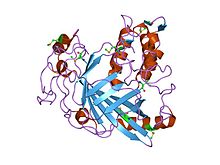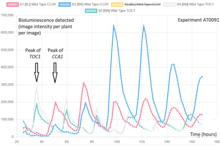Luciferase
| Bacterial Luciferase monooxygenase family | |||||||||||
|---|---|---|---|---|---|---|---|---|---|---|---|
| Identifiers | |||||||||||
| Symbol | Bac_luciferase | ||||||||||
SCOP2 | 1nfp / SCOPe / SUPFAM | ||||||||||
| |||||||||||
| Dinoflagellate Luciferase catalytic domain | |||||||||
|---|---|---|---|---|---|---|---|---|---|
 crystal structure of a luciferase domain from the dinoflagellate Lingulodinium polyedrum | |||||||||
| Identifiers | |||||||||
| Symbol | Luciferase_cat | ||||||||
| Pfam | PF10285 | ||||||||
| InterPro | IPR018804 | ||||||||
| |||||||||
| Dinoflagellate Luciferase/LBP N-terminal domain | |||||||||
|---|---|---|---|---|---|---|---|---|---|
| Identifiers | |||||||||
| Symbol | Luciferase_N | ||||||||
| Pfam | PF05295 | ||||||||
| InterPro | IPR007959 | ||||||||
| |||||||||
| Dinoflagellate Luciferase helical bundle domain | |||||||||
|---|---|---|---|---|---|---|---|---|---|
| Identifiers | |||||||||
| Symbol | Luciferase_3H | ||||||||
| Pfam | PF10284 | ||||||||
| InterPro | IPR018475 | ||||||||
| |||||||||
Luciferase is a generic term for the class of oxidative
| Search for | |
|---|---|
| Structures | Swiss-model |
| Domains | InterPro |
Luciferases are widely used in biotechnology, for bioluminescence imaging[3] microscopy and as reporter genes, for many of the same applications as fluorescent proteins. However, unlike fluorescent proteins, luciferases do not require an external light source, but do require addition of luciferin
Examples
A variety of organisms regulate their light production using different luciferases in a variety of light-emitting reactions. The majority of studied luciferases have been found in animals, including
Firefly and click beetle
The
Sea pansy
Also well studied is the
- coelenterazine + O2 → coelenteramide + CO2 + photon of light
Copepod
Newer luciferases have recently been identified that, unlike other luciferases, are naturally secreted molecules. One such example is the Metridia coelenterazine-dependent luciferase (MetLuc, A0A1L6CBM1) that is derived from the marine copepod Metridia longa. The Metridia longa secreted luciferase gene encodes a 24 kDa protein containing an N-terminal secretory signal peptide of 17 amino acid residues. The sensitivity and high signal intensity of this luciferase molecule proves advantageous in many reporter studies. Some of the benefits of using a secreted reporter molecule like MetLuc is its no-lysis protocol that allows one to be able to conduct live cell assays and multiple assays on the same cell.[8]
Bacterial
Bacterial bioluminescence is seen in Photobacterium species,
Dinoflagellate
A dinoflagellate luciferase is capable of emitting light due to its interaction with its substrate (
Hence, it can be seen that the action potential in the vacuolar membrane leads to acidification and this in turn allows the luciferin to be released to react with luciferase in the scintillon, producing a flash of blue light.Mechanism of reaction
All luciferases are classified as
Bacterial luciferase
The reaction catalyzed by bacterial luciferase is also an oxidative process:
- FMNH2 + O2 + RCHO → FMN + RCOOH + H2O + light
In the reaction, molecular oxygen oxidizes flavin mononucleotide and a long-chain aliphatic aldehyde to an aliphatic carboxylic acid. The reaction forms an excited hydroxyflavin intermediate, which is dehydrated to the product FMN to emit blue-green light.[12]
Nearly all of the energy input into the reaction is transformed into light. The reaction is 80%
Applications
Luciferases can be produced in the lab through
In the luciferase reaction, light is emitted when luciferase acts on the appropriate
In biological research, luciferase is commonly used as a reporter to assess the
Luciferase can also be used to detect the level of cellular ATP in cell viability assays or for kinase activity assays.[20][21] Luciferase can act as an ATP sensor protein through biotinylation. Biotinylation will immobilize luciferase on the cell-surface by binding to a streptavidin-biotin complex. This allows luciferase to detect the efflux of ATP from the cell and will effectively display the real-time release of ATP through bioluminescence.[22] Luciferase can additionally be made more sensitive for ATP detection by increasing the luminescence intensity by changing certain amino acid residues in the sequence of the protein.[23]

Whole organism imaging (referred to as in vivo when intact or, otherwise called ex vivo imaging for example of living but explanted tissue) is a powerful technique for studying cell populations in live plants or animals, such as mice.
Luciferase is a heat-sensitive protein that is used in studies on
See also
References
- ^ Lee J (28 February 2014). "A History of Bioluminescence". photobiology.info. Archived from the original on 29 March 2015.
- .
- PMID 34139065.
- ^ "X-Shining Thermostable Luciferase".
- PMID 3072883.
- PMID 9806891.
- PMID 2871634.
- S2CID 23916875.
- PMID 8749369.
- ^ PMID 15665092.
- PMID 11747464.
- PMID 8703001.
- .
- ^ a b Knivett V (2009). "Lighting the way". EE Times. Archived from the original on 2012-10-05. Retrieved 2011-09-18.
- ^ General Electric TP-110, p. 23, table.
- PMID 12117758.
- ^ a b "Introduction to Bioluminescence Assays". Promega Corporation. Archived from the original on 2010-08-14. Retrieved 2009-03-07.
- PMID 2785354.
- PMID 3407940.
- ^ PMID 17355205.
- ^ Meisenheimer PL, O'Brien MA, Cali JJ (September 2008). "Luminogenic enzyme substrates: The basis for a new paradigm in assay design" (PDF). Promega Notes. 100: 22–26. Archived from the original (PDF) on 2009-03-06. Retrieved 2008-10-01.
- PMID 16564487.
- PMID 17540326.
- PMID 11816060.
- PMID 14612492.
- PMID 16585152.
- S2CID 40630078.
- PMID 17254764.
External links
 Media related to Luciferase at Wikimedia Commons
Media related to Luciferase at Wikimedia Commons- Overview of all the structural information available in the PDB for UniProt: P08659 (Luciferin 4-monooxygenase) at the PDBe-KB.
- Trimmer B, Zayas R, Qazi S, Lewis S, Michel T, Dudzinski D, Aprille J, Lagace C (2001-06-28). "Firefly flashes and Nitric Oxide". Tufts University. Retrieved 2008-10-02.
- "Trends in development of reporter genes". reportergene.com. Retrieved 2009-03-07.
- "BL Web: Luciferin types". The Bioluminescence Web Page. University of California, Santa Barbara. Retrieved 2009-03-07.
- "Bioluminescence Reporters Protocols and Applications Guide". Protocols and applications. Promega Corporation. Archived from the original on 2010-08-08. Retrieved 2009-03-07.
- "BL Web: Luciferin types". ISCID Encyclopedia of Science and Philosophy. ISCID. Archived from the original on 2012-09-21. Retrieved 2010-04-20.
- Goodsell D. "Luciferase". Molecule of the Month. Protein Data Bank. Archived from the original on 2015-10-19. Retrieved 2013-01-15.
